Physical Address
304 North Cardinal St.
Dorchester Center, MA 02124
Impingement of the suprascapular nerve occurs at the scapular notch or spinoglenoid notch.
The suprascapular nerve originates from the brachial plexus, and at the scapular notch it branches into the supraspinatus and infraspinatus nerves ( Fig. 17-1 ).
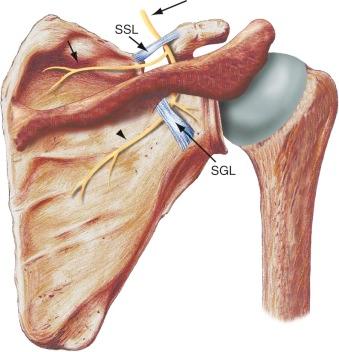
Proximal entrapment at the scapular notch results in compression of the suprascapular nerve and denervation of both the supraspinatus and infraspinatus muscles ( Figs. 17-2 and 17-3 ).
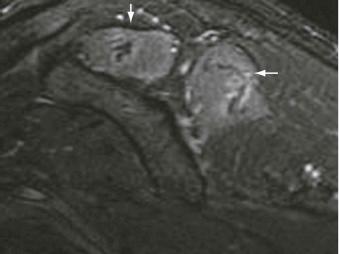
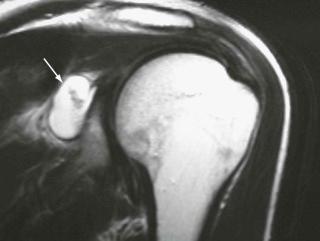
Distal entrapment at the spinoglenoid notch results in compression of the infraspinatus nerve and denervation of the infraspinatus muscle only.
Paralabral cysts (most common) ( Fig. 17-4 )
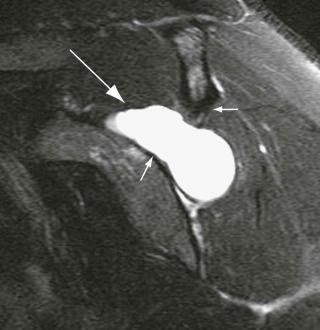
Scapular fractures and callus formations, hematomas, rotator cuff tears
Overhead activities (e.g., volleyball and tennis players, weightlifters, painters, electricians)
Soft tissue and osseous tumors, vascular malformations
Thickened transverse scapular ligament (bridges scapular notch) or spinoglenoid ligament (bridges spinoglenoid notch)
Iatrogenic (e.g., during rotator cuff repair)
Diffuse shoulder pain, diminished abduction and posterior elevation
Denervation edema (acute, increased T2 and short tau inversion recovery [STIR] signal) or fatty atrophy (chronic) of affected muscles
Rotator cuff injury, Parsonage-Turner syndrome, cervical radiculopathy
Also known as lateral axillary hiatus syndrome, it is caused by compression of axillary nerve in the quadrilateral space ( Fig. 17-5 ).
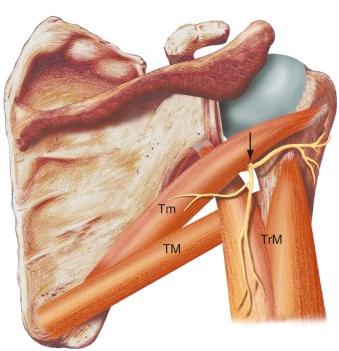
The quadrilateral space is formed by the long head of the triceps brachii muscle medially, the teres minor muscle superiorly, the teres major inferiorly, and the medial aspect of the humerus laterally.
The axillary nerve innervates the teres minor and deltoid muscles and the posterolateral cutaneous region of the shoulder and upper arm.
Proximal humeral head fractures and callus formations
Anterior shoulder dislocation resulting in traction and compression
Fibrous bands (posttraumatic)
Soft tissue and osseous tumors, paralabral cysts
Shoulder pain, paresthesias, and discrete point tenderness in lateral aspect of quadrilateral space
Denervation edema (acute, increased T2 and STIR signal and size) or fatty atrophy (chronic) of the teres minor and/or deltoid muscle ( Fig. 17-6 )
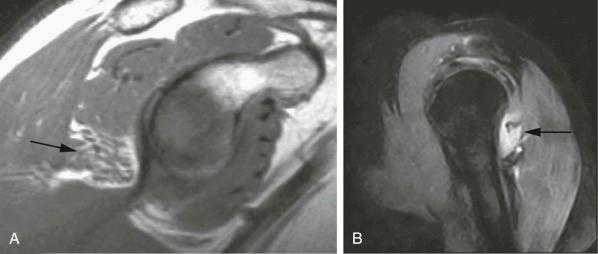
Anterior dislocation, proximal humeral fracture, brachial neuritis, Parsonage-Turner syndrome
Compression of the median nerve occurs at the level of the pronator teres muscle.
Potential sites of entrapment include the space between the superficial (humeral) and deep (ulnar) heads of the pronator teres muscle; at the origin of the flexor digitorum superficialis muscle where a fibrous arch exists; at the lacertus fibrosus, also known as the bicipital aponeurosis; and, less commonly, at the supracondylar process of the distal anteromedial humerus (avian spur) ( Figs. 17-7 and 17-8 ).
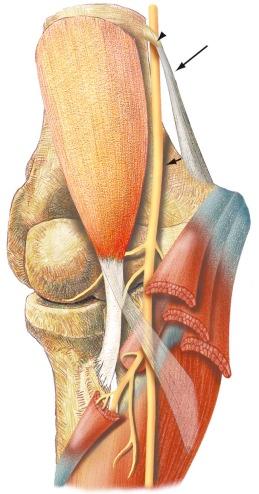
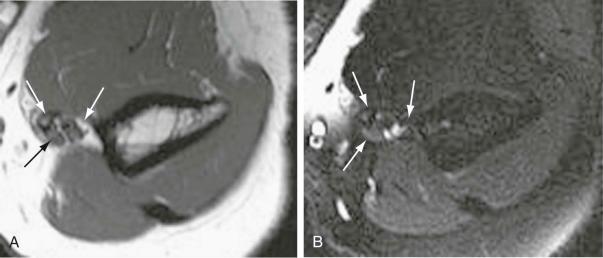
Elbow trauma, repetitive elbow flexion, supination and pronation of forearm, or, less commonly, anatomic variants (e.g., accessory bicipital aponeurosis, accessory head of the flexor pollicis longus muscle, palmaris profundus), bicipital bursitis, and soft tissue masses.
Closed reduction of elbow dislocation can also result in intraarticular entrapment of the median nerve.
Chronic pain and paresthesias in the volar aspects of the elbow and forearm and in the hand affecting the first through third digits and lateral half of the ring finger
No muscle weakness
Pain on palpation of the pronator teres muscle
Become a Clinical Tree membership for Full access and enjoy Unlimited articles
If you are a member. Log in here